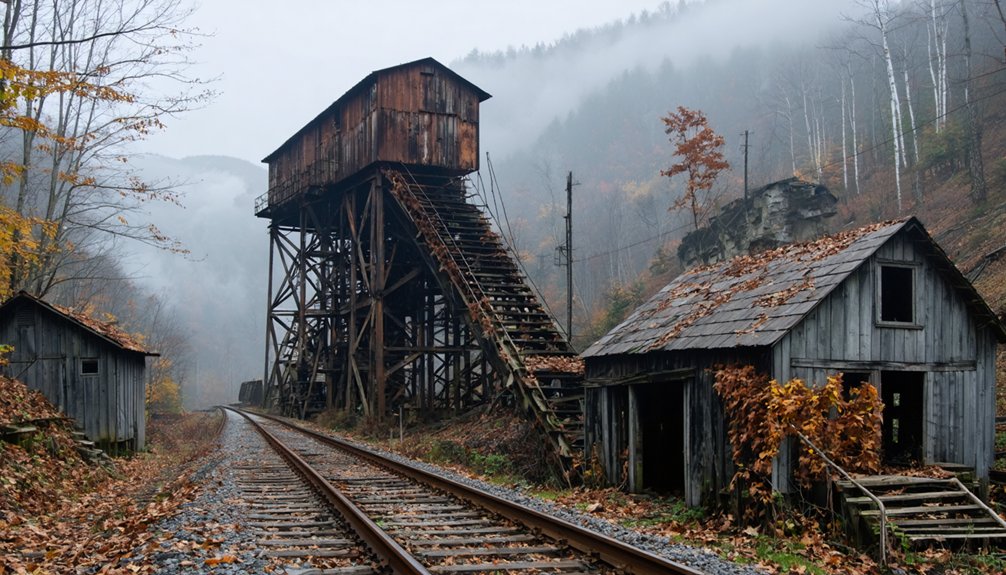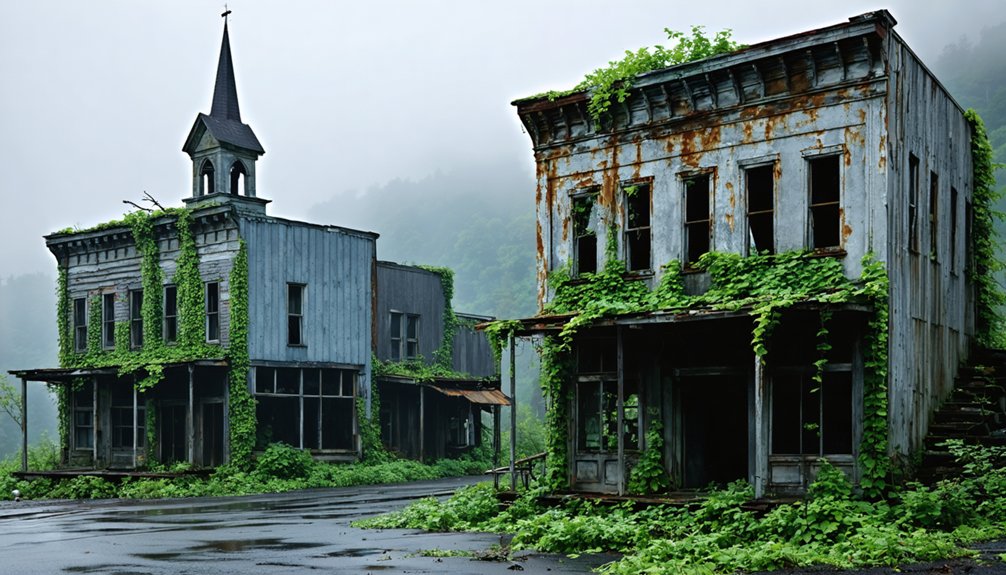You’ll find America’s most haunting coal mining ghost towns scattered through Appalachia’s misty hollows, from Thurmond’s wealthy banks to Nuttallburg’s historic tipples. These mountain treasures include Lynch’s record-breaking mines, Blue Heron’s living museum, and Kaymoor’s 821-step staircase. Each abandoned town – like Clinchco, Laquin, Quinnimont, and Stotesbury – holds generations of family stories in their weathered company stores and rusted rails. The deeper you venture into these hollers, the more secrets they’ll share.
Key Takeaways
- Thurmond’s preserved ghost town status showcases the height of C&O Railway’s coal empire, with historic buildings and only five remaining residents.
- Nuttallburg features intact coal tipples, coke ovens, and conveyor systems, offering visitors a complete view of historic mining operations.
- Lynch stands as America’s largest company-owned coal town, with preserved multicultural heritage and the first fully-electrified coal mine.
- Blue Heron’s living museum includes original mining equipment and interactive exhibits, providing immersive experiences through nighttime lantern tours.
- Kaymoor Mine presents dramatic industrial ruins, including an 821-step wooden staircase and preserved mining equipment amid Appalachian forest.
Thurmond: The Crown Jewel of New River Gorge
The whistle of steam engines once echoed through the steep walls of New River Gorge, where Thurmond stood as the beating heart of Appalachian coal country. Born in 1873 from a surveyor’s payment of 73 acres, this town became our region’s proudest achievement.
You’d marvel at Thurmond’s railroads, serving as the C&O Railway‘s crown jewel and connecting 26 bustling mines to America’s industrial might. The infamous Dunglen Hotel drew crowds of high-stakes gamblers and revelers who played poker games lasting for years.
Thurmond’s economy flourished without a single road until 1921 – just rails, determination, and grit. By 1910, our ancestors were shipping 4 million tons of coal annually, while the town’s banks grew to be West Virginia’s wealthiest. European immigrants and Southern blacks formed the backbone of this thriving mining community.
Though only five souls call it home today, Thurmond’s spirit lives on in the National Park, where you’ll find the echoes of our mountain heritage still whispering through the gorge.
Nuttallburg’s Industrial Legacy
If you’re lookin’ to understand our mountain heritage, you’ll find Nuttallburg’s story starts with John Nuttall‘s keen eye for opportunity back in 1870, when he built one of the first coal operations in the New River Gorge.
You can still see the remnants of his vision in the historic tipple and coke ovens that helped process some of the finest smokeless coal in Appalachia, shippin’ out more than 171,000 tons annually at its peak.
Today, thanks to the Nuttall family’s donation to the National Park Service in 1998, you’re able to walk these same grounds where generations of miners, including freed slaves and immigrants, once carved out their livin’ from the mountain. The community grew into a bustling town with two mine sites by 1874. Even Henry Ford saw the value here when he leased the mines in the 1920s for his automobile empire.
Historic Mining Operations Overview
Nestled deep within the New River Gorge, Nuttallburg’s industrial legacy began in 1870 when pioneering coal entrepreneur John Nuttall established what would become one of Appalachia’s most innovative mining operations.
Our mountain heritage comes alive in this remarkable mining community that shipped some of the finest bituminous coal in the region.
You’ll discover the impressive scale of Nuttallburg’s operations through these key features:
- A sophisticated conveyor system that transported coal from the mountainside to the riverside
- 80 coke ovens that processed the high-carbon, smokeless coal
- Production capacity reaching 500 tons daily at peak operation
- A workforce of 125 miners that grew to include immigrants and freed slaves
The operation later caught Henry Ford’s eye, who modernized the facilities in 1920, doubling production through innovative industrial practices.
Today, visitors can explore the ruins of brick coke ovens that still stand as testament to the town’s industrial might.
The town’s unique layout featured housing distinctly divided between east and west sides, separating black and white workers in the community.
Preservation Efforts Since 1873
Since 1998, our beloved Nuttallburg has found its forever home under National Park Service protection, marking a pivotal moment in preserving our mountain heritage.
You’ll see how preservation techniques have saved our forty-six coke ovens, coal tipples, and miners’ homes from nature’s relentless grip. The Park Service’s fight against kudzu and other invaders keeps our history visible for all to explore.
What’s special about these preservation efforts is how they’ve maintained the story of our diverse mining families – from immigrant workers to African American miners who built their own schools and churches here.
When you walk these grounds today, you’re not just seeing industrial remains; you’re experiencing the complete picture of life in a coal town, thanks to careful stabilization work that protects both structures and stories. The site showcases the remarkable button-and-rope conveyor system that revolutionized coal transportation during the Ford era.
Lynch: Kentucky’s Coal Mining Empire
Located in the rugged hills of Harlan County, Lynch stands as one of America’s most remarkable coal mining stories. When U.S. Steel established this mining empire in 1917, they created what would become the world’s largest company-owned coal camp.
You’ll find deep Lynch Heritage in every corner of this town, where your ancestors might’ve been among the 10,000 residents who called it home during its peak in the 1940s. The town was named after Thomas Lynch, who pioneered revolutionary practices in mine safety.
- First fully-electrified coal mine in America, showcasing revolutionary Mining Technology
- Workers from 38 different countries built a vibrant multicultural community
- Set a world record in 1923, shipping 12,820 tons of coal in just nine hours
- Boasted the world’s largest coal tipple and company store
Today, while much has changed, Lynch’s story lives on through its preserved buildings and the spirit of the mountain folk who shaped America’s industrial might.
Blue Heron: A Living Museum of Mining History
Once a thriving coal town built around Mine 18, Blue Heron now stands as a remarkable living museum where you’ll experience Appalachian mining heritage through the eyes of those who lived it.
The National Park Service carefully maintains and preserves this historic site for future generations to explore. As you walk the paved loop trail, you’ll find skeletal buildings that tell stories of the Stearns Coal & Lumber Company’s operation that ran from 1937 to 1962. The preserved coal tipple and loading equipment remind us of the backbreaking work our mountain folk endured. Interactive exhibits at the old train depot provide fascinating details about Blue Heron’s history.
What makes Blue Heron special is the living history you’ll discover through recorded voices of former residents, sharing tales of their daily lives in this tight-knit community.
At night, oil lantern tours let you step back in time, experiencing the authentic mining culture that shaped our Appalachian heritage along the Big South Fork River.
Kaymoor’s Hidden Staircases and Ruins

As you step onto Kaymoor’s 821-step wooden staircase, you’ll find yourself following the same descent into the New River Gorge that generations of coal miners once traveled.
Your journey down reveals the scattered remains of mining equipment, from rusted machinery to the old lamp house and superintendent’s office, all slowly being reclaimed by nature.
Through the dense Appalachian forest, you can still make out the distinct levels where our mining ancestors worked the coal seams, with the coke ovens and processing plant ruins telling the story of their daily labors.
Historic Equipment Remains
The towering 821-step wooden staircase at Kaymoor mine serves as a gateway to one of Appalachia’s most remarkable industrial ruins.
As you descend, you’ll find yourself surrounded by remnants of our region’s coal mining heritage, where equipment preservation efforts protect these precious mining artifacts from time’s relentless march.
- A massive 20-foot steel water tank still stands proudly on its concrete foundation
- Rusted I-beam tracks from the mountain haulage system trace the paths of countless coal loads
- The 1950s cinderblock lamp house and superintendent’s office remain as silent sentinels
- Moss-covered machinery and equipment dot the landscape, telling stories of hard work
These industrial relics, now wrapped in vines and rust, remind us of the determination that built our mountain communities and shaped our ancestors’ lives.
Descent Into Mining Past
Winding down through dense Appalachian forest, an 821-step wooden staircase beckons modern-day explorers into Kaymoor’s rich mining heritage.
You’ll follow the same path your coal-mining ancestors took, where Claude Elmer’s original wooden and concrete steps once carried workers between their homes and the mine portal.
As you descend, you’ll spot remnants of the old haulage system’s I-beam tracks that parallel your journey.
The National Park Service rebuilt these stairs in 1995, preserving this crucial connection to our mining history.
At the bottom, you’ll discover what’s left of a once-bustling coal town – the processing plant ruins and scattered remains of company stores, schools, and churches that thrived until 1952.
Each step down reveals another layer of Appalachian industrial heritage waiting to be rediscovered.
Nemacolin: Pennsylvania’s Preserved Coal Community
Built alongside the mighty Monongahela River in 1917, Nemacolin stands as one of Pennsylvania’s most remarkable coal company towns.
You’ll find a community that once thrived under Youngstown Sheet and Tube Company‘s grip, where the economic impact reached its peak as America’s largest coal mine in 1919.
Unlike many company towns, Nemacolin offered its residents an impressive array of amenities:
- A grand 550-seat theater where families gathered for entertainment
- Modern facilities including a swimming pool, hospital, and sewage treatment plant
- Well-maintained duplexes with pristine lawns and gardens
- Independent stores that challenged the company store’s monopoly
Clinchco’s Mountain Mining Heritage

Deep in Virginia’s rugged Dickenson County, Clinchco emerged as a demonstration to coal’s transformative power in the early 1900s. Your great-grandparents might’ve been among those who flocked to this coal camp when the Clinchfield Coal Company carved out a community from the mountainside.
They built their lives around the rhythm of the mines, with women tending to homes while men descended into the earth’s depths.
You’ll find echoes of Clinchco history in every abandoned building – the company store where families once gathered, the hospital that cared for injured miners, and the rail lines that carried coal to distant markets.
Though the mines have fallen silent and many families have moved on, Clinchco’s spirit lives on through preserved photographs and stories, reminding us of our mountain heritage’s strength and resilience.
Laquin: From Lumber to Coal Ghost Town
While our Appalachian towns often started with coal, Laquin charted a different path through Pennsylvania’s hardwood forests in the early 1900s.
Our grandfathers tell stories of Laquin’s heritage, when the town buzzed with sawmills and chemical plants, crafting everything from wagon wheel hubs to brewing supplies for Anheuser-Busch.
You’ll find these remnants of Laquin’s industrial ruins today:
- Towering retort ovens where they extracted chemicals from wood
- Vast drying yards where hardwood pieces once seasoned
- Old factory buildings with their weathered smokestacks
- Abandoned rail lines that once carried lumber and coal
The town’s spirit faded after ’32 when the chemical plant closed, but you can still walk these grounds where innovative minds transformed lumber into chemicals, marking an important chapter in Appalachian industrial ingenuity.
Quinnimont: Rails and Coal in the Gorge

As you wander through the New River Gorge today, it’s hard to imagine that Quinnimont once sparked the region’s coal revolution in 1872.
Colonel Joseph Beury, whose legacy stands tall in a 25-foot monument, established the first major coal operation here, shipping New River Smokeless Coal via the newly-laid C&O tracks.
The railway expansion transformed this once-quiet farming community into a bustling hub of over 500 souls.
You’ll find traces of the old mining culture in the remnants of coal tipples and rail yards that connected countless coal camps.
Though the town practiced segregation, miners shared an unspoken brotherhood underground, facing the same dangers in the dark depths.
Quinnimont’s story, as the oldest European settlement in the gorge, lives on in the New River Gorge National Park.
Stotesbury’s Lost Company Town
Just south of Quinnimont’s historic rail yards, you’ll find another ghost of our region’s coal heritage – Stotesbury.
Our grandparents tell stories of this once-bustling company town, built by E.E. White Coal Company in the steep Appalachian mountains. The town’s history reflects both the promise and pain of our past, marked by racial segregation that divided families between separate churches and facilities.
In these mountains, company towns like Stotesbury embodied both progress and prejudice, where coal’s promise came wrapped in segregation’s chains.
When you venture up those winding mountain roads today, you’ll discover:
- St. John’s Baptist Church from 1918, a tribute to the African American community’s resilience
- Crumbling company houses slowly returning to nature
- Empty streets where coal miners’ children once played
- A few elderly residents who keep the town’s memories alive
Like many of our mountain mining communities, Stotesbury’s decline began when the coal gave out in the 1960s.
Frequently Asked Questions
Are There Guided Tours Available for Visiting These Abandoned Mining Towns?
You’ll find guided exploration options through National Park Service tours, local historians, and heritage groups, plus some underground mine experiences that’ll connect you with your mountain mining historical significance.
What Safety Precautions Should Visitors Take When Exploring Mining Ruins?
Pack proper protection: wear sturdy boots, bring exploration gear, and don’t venture alone. You’ll need a hardhat, flashlight, and first-aid kit. Tell folks where you’re heading before exploring.
Can Metal Detecting or Artifact Collecting Be Done at These Sites?
You can’t legally metal detect or collect artifacts from most mountain mining sites. These treasures tell your ancestors’ stories, so it’s best to photograph and document while preserving our shared heritage.
Which Abandoned Mining Towns Are Most Accessible During Winter Months?
Like ancient sentinels guarding mountain memories, you’ll find Lynch, Kentucky and Cumberland, West Virginia most welcoming in winter. Their maintained roads and local climate guarantee you’re free to explore your heritage year-round.
Do Any of These Ghost Towns Still Have Active Mining Claims?
You’ll find most of our ancestral mining towns don’t have active claims anymore, though some spots with historical significance might still carry old mineral rights passed down through generations.
References
- https://en.wikipedia.org/wiki/List_of_ghost_towns_in_Pennsylvania
- https://www.youtube.com/watch?v=DbNFfyh0OzY
- https://newrivergorgecvb.com/abandoned-wv-coal-towns/
- https://www.youtube.com/watch?v=RRS9TL_PLsA
- https://appalachianmemories.org/2025/10/16/the-lost-towns-of-appalachia-the-forgotten-mountain-communities/
- https://albiongould.com/ghost-towns-to-visit-in-the-states/
- https://www.youtube.com/watch?v=hKXyVRX0FQM
- https://discover.hubpages.com/education/Old-coal-mining-towns-of-Appalacia-linger-in-the-past
- https://www.blueridgeoutdoors.com/go-outside/southern-ghost-towns/
- https://www.legendsofamerica.com/thurmond-west-virginia/



